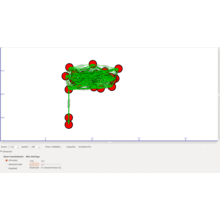VANET Simulation
What is VANET Simulation?
Vehicular ad hoc network (VANET) simulator is considered as rapidly changing network topology with the regular basis of high speed moving nodes. The applications based on VANET simulation are permitting the vehicles to connect the internet to acquire the data about traffic, disaster reports and accident information.
Architecture Design of VANET Simulator
The structural design of VANET simulator includes three significant sections such as
- Network simulator
- Mobility generator
- Middleware framework
- It is deployed to combine the both the network simulator and mobility generator
In VANET simulators, the reality level of the simulation has to be increased through the functions of vehicular mobility generators. These generators are used to generate the real time vehicular mobility traces and that is considered as the input of network simulator. The traces generated through the vehicular mobility include the description about the location of all the nodes in the network at every tine instant of the simulation and that consist of the profiles based on mobility.
The inputs to mobility generators consists various types of road and the consequential factors and the parameters such as
- Maximum and minimum speed velocity of the nodes
- Rate of arrivals and departure
In addition, some other parameters are also deployed in the process of mobility generators and on the other hand several mobility generators have utilized in the VANET simulators such as
- Netstream
- FreeSim
- CityMob
- MOVE
- SUMO
Some of the fundamental tasks based on simulator are implemented through the network simulators when they are performing the packet level simulation of source and destination, sending and receiving process of data traffic. Additionally, several network simulators are deployed in the VANET simulation and they are enlisted in the following.
- OMNeT++
- OPNET
- GTNetS
- GloMoSim
- Ns2
The depiction of middleware framework is the integration among the traffic flow simulation and network simulation. It is accountable for the regulation of communication among them through creating the two way link among the simulators when they are simulating in parallel manner. Several vehicular ad hoc network frameworks are utilized in the VANET simulators such as,
- VEINS
- GroveNet
- NCTUrs
- TraNS
Vehicular Mobility Modeling Approaches
The vehicular mobility modeling includes various approaches for the creation of mobility generator in the vehicular as hoc network simulation. In addition to that, our research professionals have enlisted the significant approaches used in this process of VANET such as,
- Trace and survey models
- The traces that are collected from network simulators are assistive to model the mobility model and that is related to the provided traces. In addition, the survey of driver’s characteristics is denoted as another source of information which is helpful to build the mobility model. The absence of traces is considered as the notable challenge in the big data modeling
- Behavioral models
- The behavioral models are based on the studied characteristics of the driver through the artificial intelligence over the introduction of learning techniques to study characteristics of the driver and the driver is the human
- Flow models
- Characteristics of vehicle interaction with the surrounding environment and neighbors. The mobility generator in modeling is applicable in the process of VANET and it includes three significant types of flow models such as
- Microscopic modeling
- Mesoscopic modeling
- Macroscopic modeling
- Random models
- The patterns in random mobility is mainly deployed in the fields of telecommunication and computer science because if the stochastic properties based on the distribution of nodes in the network. These patterns are not applicable for the vehicles in vehicular ad hoc network which are moving in the well-known trajectories and roads not moving in random method
- Traffic models
- All the factors in surrounding may affect the traffic what the vehicle follows such as
- Global path
- Road traffic red and green light
VANET Mobility Generators
- FreeSim
- The freesim mobility generator is the freeway traffic simulator and that models used to free up the flow of transportation systems and that is weighted to the direction of graphs that are determined through the current speed
- It is functional in both the microscopic and macroscopic mobility simulator and is deployed to model the macroscopic phase of the network in which the vehicles can communicate with the simulator to get the feedback of traffic
- SUMO
- Simulation of urban mobility is abbreviated as the SUMO and it is denoted as the multi modal traffic, microscopic, continuous and collision free simulation
- SUMO is the open source mobility generator to assist the simulation process in networks with the provision of network simulators with some realistic traces and to model the network and the analyze execution of designed network
- It has the capacity to model the large cities of mobility networks with one million vehicles in the networks
- MOVE
- Mobility model generator for vehicle networks is abbreviated as MOVE and it is considered as the mobility generator which is created through the top of SUMO simulator to create the realistic mobility traces and that is apt for the input of network simulators such as
- Qualnet
- Ns2
- It is executed thorough the functions of JAVA with two main components
- Vehicle movement editor
- It is deployed to create the road topology and maps are generated through both the automatic and manual process and that can be openly imported from the Google earth
- Map editor
- It is assistive for the users to define the routes and the trips where the vehicles in the networks can proceed. In addition, the process depicts the routes and some other elements of route such as
- Duration of trip
- Destination of the vehicle
- Departure time of the vehicle
- Vehicles inside the route
The network simulators are utilized in the vehicular ad hoc networks to execute and simulate the proposed network along with the provided traces through the vehicular mobility generator to acquire the real time results and the characteristic analysis of network over applying protocol in the VANET simulation.
VANET Simulator
- OMNeT++
- The components and modules based on OMNeT++ are programmed through the utilization of C++ language with the new version of software and the process of programming modules with the C++ class library which includes the kernel of simulation
- Network description is considered as the high level language and that is utilized to accumulate the single components with large components and models
- It includes the external extensions and it permits the support for wireless networks simulations with the two significant extensions such as
- Veins framework
- Mobility framework
- Ns2
- It is denoted as the Ns2 distribution code with some shortcomings in the structural design and it is functional in both the IEEE 802.11 MAC and physical modules
- Alterations in the structural design and two modules are done with the simulator with results in PHY layer with the support of signal frame channel communication network and MAC layer of CSMA mechanism is essential for the reliable techniques
- Ns3
- Ns3 is assistive for both the simulation and emulation with the utilization of sockets in which the hardware is capable to connect Ns3 simulator for the emulation process with the utilization of sockets. Network simulators version 3 is capable to generate traces with the assistance of debugging the results of obtained part of simulation. In addition, it provides the real time environment with well-organized source code
Our knowledgeable research team supports your research work based on VANET simulation with the help of many advanced technologies and algorithm parameters. Here, we have provided the sample research project topics that we guided recently for your reference.
Thesis Titles
- Integrity and authentications for service security in vehicular ad hoc networks (VANETs)
- Optimization of the 5G VANET routing protocol on AODV communication with static intersection node
- A review of digital signature and hash function based approach for secure routing in VANET
- an adaptive full duplex deep reinforcement learning based design for 5G-V2X mode 4 VANETs
- A new hybrid routing protocol using a modified K-Means clustering algorithm and continuous Hopfield network for VANET
Through this article, we have given you a very broad picture based the VANET simulation. In this the research scholars can find complete research information regarding the implementation process of simulation, modeling approaches, benefits, toolboxes and etc. We have been guiding the research scholars for more than 20+ years. We have earned huge reputation among the research scholars and professors across the best universities of the world. This reputation is due to our quality, originality, novelty, on time delivery and more. Therefore, the research scholars can reach us to fulfill all your research requirements with the best innovations and novel executions with the support of our research experts.

 Click Here to watch our latest output video using NS3 simulator
Click Here to watch our latest output video using NS3 simulator  Click Here to watch our latest projects screenshots using NS3 simulator
Click Here to watch our latest projects screenshots using NS3 simulator